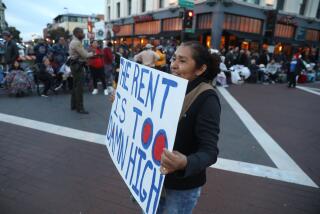Ruin Rooted in 1980s Borrowing
- Share via
NEW YORK — If you borrowed money at 10% in order to invest it at 8%, you might be considered crazy.
Except in commercial real estate.
In that strange practice, says real estate adviser Allen Cymrot, lies the basic explanation of the amazing real estate, savings and loan, banking and insurance busts of the past few years, with perhaps more to come.
All involve so-called experts. All made deals with the same flaw, that is, negative spread, a red flag in other industries, even to relatively naive investors. But in real estate it happens all the time.
Cymrot, who heads Cymrot Realty Advisers in Los Altos Hills, says negative spread simply means “the more money you borrow the more you lose.”
Why, then, was it practiced so vigorously during the 1980s?
Cymrot encountered the situation so often that he sat down recently to think it through; to understand how it all happened, and he came up with his own dissection of lender and borrower psychology.
These, he says, are some of the elements of an environment that motivated American society into an unreasonable borrowing process, one that destroyed otherwise sound business institutions and worsened the recession:
* The government’s attitude toward the federal deficit, which was like a smoker’s attitude toward cigarettes: Since the damage couldn’t be seen, it was OK. That thinking filtered down, as from parent to child: Debt is good.
* The structure of three major institutions--savings and loans, insurance companies and commercial banks--which earn much of their profits from lending money at rates higher than what they pay on deposits or premiums.
* The notion, prevalent in those giddy days, that leverage was a necessary tool for accumulating wealth. That and small down payments exacerbated the effect of negative spread.
* The prevailing “wisdom” of the time, that if you held on long enough real estate would work out, even if you had negative cash flow. Rising rents and selling prices would make it possible. Inflation would bail you out.
* Government tax incentives to leverage.
* The brokerage industry, motivated by compensation based on commissions. Higher and higher prices and frequent transactions raised profitability. Leverage helped realize those goals.
* The mortgage brokerage industry, which was based entirely on creating larger and larger mortgages.
* Title companies, which required real estate transactions to create earnings. To an extent, the same might be said of lawyers, accountants, appraisers and others whose businesses surge when real state booms.
In the 1980s, these factors caused commercial real estate to become vastly overbuilt. Prices didn’t continue rising. Rents fell. The negative cash flow eroded investor equity. It spread to lenders.
It is still happening. Large banks have been forced to write off billions in loans. As values fall, insurer investors are shaking. Behemoth real estate firms with experience and sophistication struggle to survive.
The same leaders in real estate who were celebrated a few years ago are now in a survival battle, along with their investors and lenders.
Olympia & York can’t pay its bills. The Trammel Crow organization was forced to trade equity for better loan terms. Donald Trump’s empire was forced to restructure debt and shrink its holdings.
“Mathematics isn’t kind to poor investments,” says Cymrot. “The fact is that when you borrow money on a negative spread, you are likely to lose money on the amount you borrow.
“The more money you borrow, the more money you will lose. It’s a matter of mathematics.”
More to Read
Inside the business of entertainment
The Wide Shot brings you news, analysis and insights on everything from streaming wars to production — and what it all means for the future.
You may occasionally receive promotional content from the Los Angeles Times.








